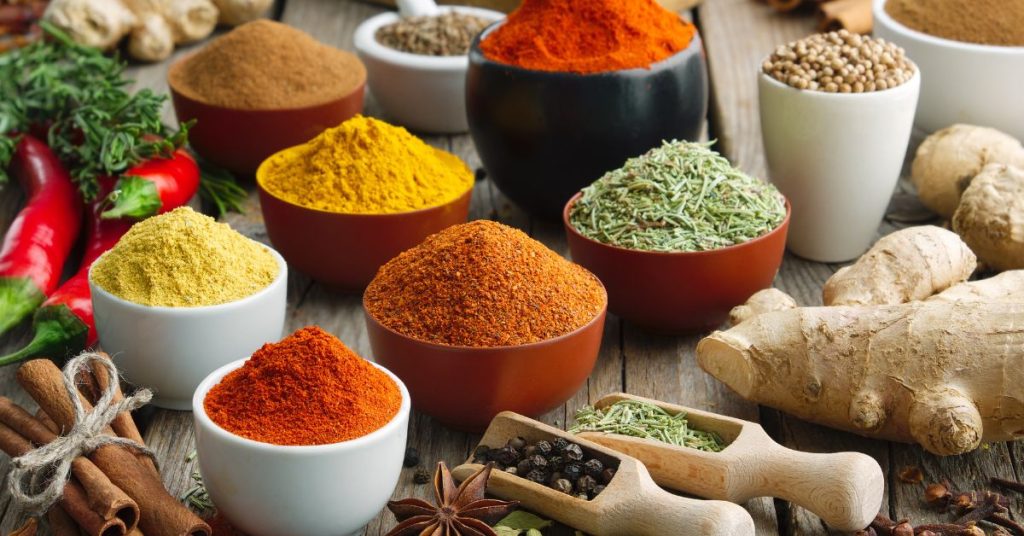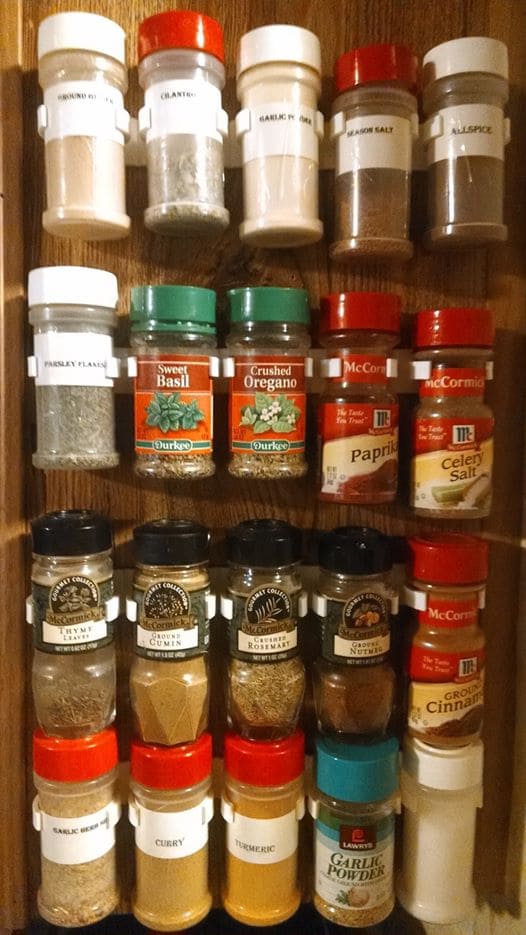

In my whole foods, plant-based kitchen I do a lot of cooking. Having plenty of spices on hand is important in helping create masterpieces! At this moment, there are no less than 50+ different spices adorning my spice clips and shelves. Some, I use only occasionally; others, I use constantly.
I want to share the top 15 spices and flavorings I use on a regular basis to create amazingly flavorful and healthy plant-based dishes. They are listed in no particular order. Here we go!
1. Italian Seasoning is a mixture of oregano, basil, rosemary, thyme, and garlic. I buy it already blended, and it can be purchased at most local grocery stores. It’s used in pasta dishes, lasagna, tomato sauce, spaghetti, and many other dishes.
2. Garlic Powder is a must! It gives dishes a slight garlic flavor without the texture, so disperses well in liquids like salad dressings and sauces.
3. Onion Powder is another necessity. It can’t replace fresh onions, but it definitely has a prominent place in the kitchen to add flavors to all kinds of dishes and sauces. The long shelf life is another plus if you don’t use fresh onions often enough to merit keeping them on hand.
4. Paprika (and Smoked Paprika) is made from dried fruits of the chili pepper family. My Creamy Vegan Cheese Sauce is one of many recipes where its flavor is irreplaceable. Smoked paprika is one of my absolute favorites!
5. Peppercorn Mélange is a colorful blend of whole black, white, green, and pink peppercorns. I love to add it to tofu scramble, hash browns, baked potatoes, and many other dishes.
6. Turmeric is from the ginger family and has its origins in India. Its color is orange-yellow, and dishes that it’s used in will take on the coloring. When used in a tofu scramble,it gives the appearance of the yellow coloring of eggs.
7. Tarragon has a unique flavor that easily dominates other flavors, if used too heavily. It pairs well with artichokes, carrots, mushrooms, onions, potatoes, salads, and spinach. I add it to many dishes, including my homemade veggie broth.
8. Cayenne Pepper is my favorite go-to for adding a little kick to my family’s favorite recipes. It’s another one that goes into sauces, dips, and so much more. It also has many health benefits.
9. Chili Powder is the dried, pulverized fruit of the chili pepper. This is a very important spice that I use in my chili recipes.
10. Cumin is native from the east Mediterranean to India. It adds an earthy warm feeling to many soups and stews. It also has many medicinal purposes.

11. Steak Seasoning is one I bet you weren’t thinking you’d hear on a plant-based blog. It is made from grinding black pepper, paprika, kosher salt, granulated garlic, dill seed, coriander seed, and red pepper flakes. I purchase it already blended at my local grocery store, and add it to tomato sandwiches, baked potatoes, hash browns, steamed veggies, rice, and almost any dish to give that extra punch of flavor.
12. Bay Leaf is one of my favorites for homemade veggie broth, soups, stews, and a crock pot full of beans.
13. Nutritional Yeast is a seasoning I wouldn’t want to be without! It adds a nutty, cheesy flavor to pastas, sauces, dips, baked potatoes, and many other dishes. My favorite brand is Kal, and I use it so much that I buy in bulk to save money. If you do much plant-based cooking, I’m betting you’ll find yourself using a lot too.
14. Pure Vanilla is more accurately called a flavoring than a spice, but I wanted to make sure to include it in this list. My favorite brand is McCormick’s because it comes in large bottles, saves me money, and the flavor is excellent. I use this in many desserts like Chocolate Mousse, Pumpkin Walnut Raisin Cookies, and Chocolate Banana Smoothies.
15. Sauces that I consider necessities are: Bragg’s Amino Acids, soy sauce, tamari, and Worcestershire sauce. These all add a distinct and robust flavor to many recipes. When purchasing Worcestershire sauce, make sure to read the label and choose one without anchovies. It doesn’t have to be expensive or say VEGAN on it. My experience has been that some of the no-name, cheaper brands are anchovy-free.
Creating new, healthy recipes with all my spices is like science and art brought together. Science, because of nutrition—using the power of foods to promote healing within the body. And art, because of beauty and uniqueness—capturing the visual appeal. Not to mention, it has to taste amazing. Having a full spice rack helps me do that!
NOTE: I also use coarse sea salt with iodine in most of my dishes. The excess sodium that most Americans consume comes from processed foods, not a salt shaker. When switching to a whole foods, plant-based way of life, sodium is not usually an issue in my experience.
Copyright 2025 Center for Nutrition Studies. All rights reserved.